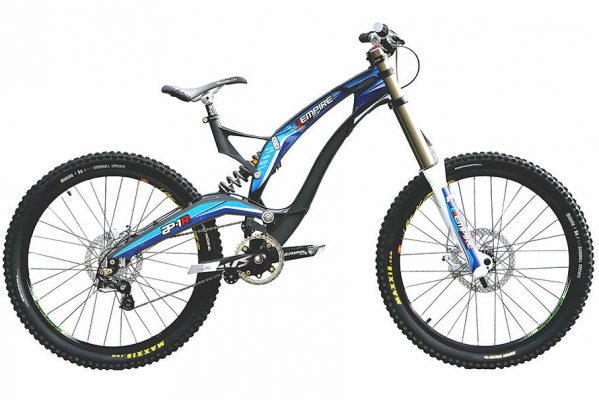Every brand and their dog has a high pivot idler design these days. Trek, Norco, Commencal... We look back to the mid noughties when UK's Empire Cycles offered a unique downhilling machine called the AP1.
Back in 2006 big things were afoot in a small village in the hills of Rossendale. Craig Robertson, working with industrial designer Chris Williams came up with a new bike brand and a totally new machine. Empire Cycles and the Ap1 offered a unique downhilling machine.
Read more: Best electric mountain bikes – join the riding revolution!

“Why weld thirty pieces together when you can mould three?” – Empire Cycles
The Empire Cycles AP1 had a cast aluminium frame. It was made in three pieces — entirely in the UK — and had 8.5in of travel (this was the era of the Santa Cruz V10 and Trek Session 10 when 8in wasn’t deemed enough. Empire’s AP1 had a rearward axle path delivered by a single pivot design. The swingarm er, swung on 28mm needle bearings (as used on Ricky Charmichael’s Moto X bikes docha know) and had a hollow steel axle at its heart which was heat treated and coated for longevity.
And yep, it had an idler to combat the chain growth caused by that rearward axle path.
The unique cast frame construction is designed and manufactured in the UK, and while it’s a popular manufacturing technique for motorcycles, this was the first time we’d seen a cast downhill frame.

As you can see, the geometry looks positively Medieval compared to bikes of today (65° is practically XCO now) but it was par for the course in its day, and at least it’s 1.5in head tube meant you could bung an Angleset in there if you wanted to. Slotted, toothed wheel adjusters offered an inch and a half of chainstay tweaking. Chainstay length was adjustable between 426mm and 446mm and travel varied from 203mm to 216mm depending on the chosen chainstay length.
Swingarm spacing was 150mm, but the AP1 actually used a 135mm hub (to save weight where it counts and build into a reduced dish wheel) allowed space for the sliding disc mount, which was also mounted on the 12mm rear axle. An added bonus of this set-up is that the disc mount is always perfectly aligned with the hub and rotor.
Although it wasn’t exactly light – the frame weighed around 13.5lbs including shock, brake carrier, axle and attendant hardware – the AP1 sported an impressive sprung/unsprung mass ratio. Basically, like a modern day eMTB, the main frame was flipping heavy and thus maintained a stability relatively unaffected by bumps coming from below; the wheels and hollow swing arm (ie. the suspension) took all the hardship.




